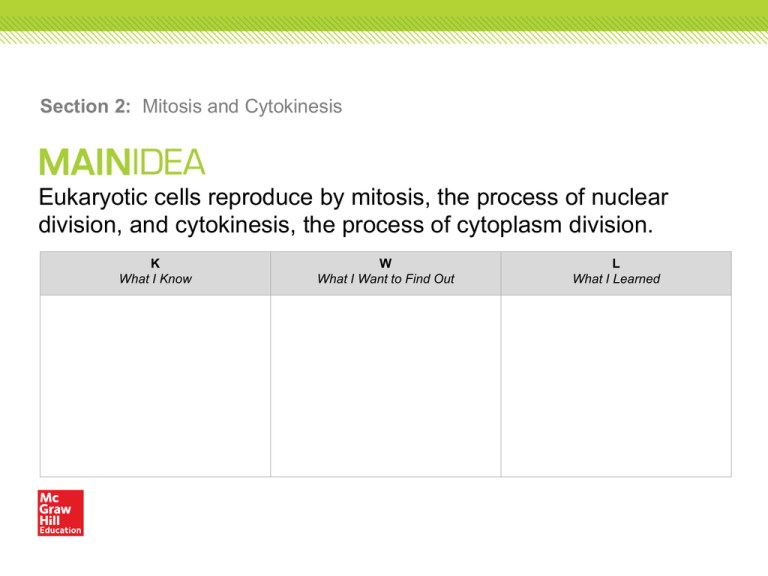The Stages of Mitosis
advertisement

Section 2: Mitosis and Cytokinesis Eukaryotic cells reproduce by mitosis, the process of nuclear division, and cytokinesis, the process of cytoplasm division. K What I Know W What I Want to Find Out L What I Learned • • 5(A) Describe the stages of the cell cycle, including deoxyribonucleic acid (DNA) replication and mitosis, and the importance of the cell cycle to the growth of organisms. 4(B) Investigate and explain cellular processes, including homeostasis, energy conversions, transport of molecules, and synthesis of new molecules. Copyright © McGraw-Hill Education Mitosis and Cytokinesis Essential Questions • What are the events of each stage of mitosis? • What is the process of cytokinesis? Copyright © McGraw-Hill Education Mitosis and Cytokinesis Vocabulary Review New • • • • • • • • life cycle Copyright © McGraw-Hill Education prophase sister chromatid centromere spindle apparatus metaphase anaphase telophase Mitosis and Cytokinesis Mitosis • During mitosis cell’s replicated genetic material separates and the cell prepares to split into two cells. • The key activity of mitosis is the accurate separation of the cell’s replicated DNA. • Mitosis: • Increases the number of cells in a multicellular organism as it grows • Replaces damaged cells Copyright © McGraw-Hill Education Mitosis and Cytokinesis The Stages of Mitosis (Mitosis Rap) Prophase • Prophase is the first and longest stage of mitosis. • Cell’s chromatin tightens/condenses into chromosomes. • Sister chromatids are structures that contain identical copies of DNA. • The sister chromatids are attached at the centromere. Copyright © McGraw-Hill Education Mitosis and Cytokinesis The Stages of Mitosis Prophase • As prophase continues, spindle fibers, centrioles, and aster fibers form a spindle apparatus. • The spindle apparatus attaches to each of the sister chromatids before cell division. Copyright © McGraw-Hill Education Mitosis and Cytokinesis The Stages of Mitosis Metaphase • The second stage of mitosis is metaphase – the shortest phase. • Sister chromatids are pulled along the spindle apparatus toward the center of the cell. • They line up in the middle of the cell. Copyright © McGraw-Hill Education Mitosis and Cytokinesis The Stages of Mitosis Anaphase • During anaphase, the chromatids pull apart. • The microtubules of the spindle apparatus begin to shorten. • The sister chromatids separate. • The chromosomes move toward the poles of the cell. Copyright © McGraw-Hill Education Mitosis and Cytokinesis The Stages of Mitosis Telophase • Telophase is when the chromosomes arrive at the poles and begin to decondense. • Two new nuclear membranes begin to form and the nucleoli reappear. • The spindle apparatus disassembles. Copyright © McGraw-Hill Education Mitosis and Cytokinesis Cytokinesis • After the two daughter nuclei have formed, cells undergo cytokinesis. • In animal cells, microfilaments constrict/pinch off to form two cells. • In plant cells, instead of pinching in half, a new structure called the cell plate forms between the two daughter nuclei. Copyright © McGraw-Hill Education Mitosis and Cytokinesis Visualizing the Cell Cycle Animation FPO Add link to animation from page 249 (figure 6) here. Copyright © McGraw-Hill Education Mitosis and Cytokinesis Review Essential Questions • What are the events of each stage of mitosis? • What is the process of cytokinesis? Vocabulary • • • prophase sister chromatid centromere Copyright © McGraw-Hill Education • • spindle apparatus metaphase • • anaphase telophase Mitosis and Cytokinesis




